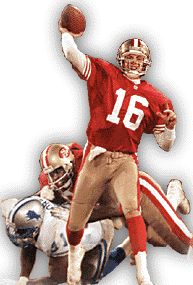
Passing Plays
.
.
.
|
|
|
|
|
|
|
|
|
|
|
|
|
|
|
|
|
|

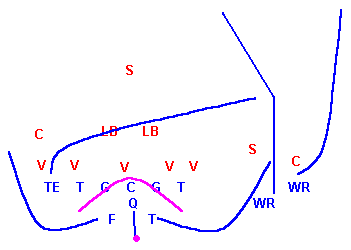 The Fan
is a passing play typically run from the Veer Formation but can be run
from any formation featuring at least two receivers to the same side.
The TE's 10 yard pattern is run slowly as in a "drag" and is run after
blocking for one count. If two backs are in the backfield, one can
stay in the pocket for pass protection if needed and/or release into his
pattern late--as a safety valve. The Line pass protects in
the pocket style. This of course means the QB must drop straight
back and his running lane of escape is straight forward. The basic
concept is to clear out the flat area by sending both wide outs deep, then
filling the flat with two short patterns. The two points of attack
are the deep threats and the exposed flat. Primary receivers can
be specified as needed. The default order of preference is first
the Fly, then Post, Float, and finally the Curl. The Shotgun Formation
is also an option. The play can also be run as a roll out but the
line's blocking scheme must be changed from the pocket to the Fence style.
The Fan
is a passing play typically run from the Veer Formation but can be run
from any formation featuring at least two receivers to the same side.
The TE's 10 yard pattern is run slowly as in a "drag" and is run after
blocking for one count. If two backs are in the backfield, one can
stay in the pocket for pass protection if needed and/or release into his
pattern late--as a safety valve. The Line pass protects in
the pocket style. This of course means the QB must drop straight
back and his running lane of escape is straight forward. The basic
concept is to clear out the flat area by sending both wide outs deep, then
filling the flat with two short patterns. The two points of attack
are the deep threats and the exposed flat. Primary receivers can
be specified as needed. The default order of preference is first
the Fly, then Post, Float, and finally the Curl. The Shotgun Formation
is also an option. The play can also be run as a roll out but the
line's blocking scheme must be changed from the pocket to the Fence style.
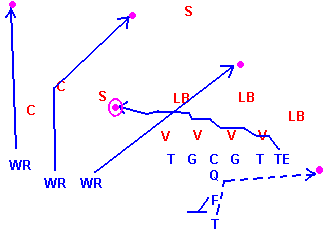 The
Clear Out Pass is intended as a misdirection type play. The idea
is to set three wide outs to one side, then send them all on quick developing
patterns that quickly remove them from their area of origin. In the
meanwhile the tight end from the other side of the formation runs a "Drag"
pattern, slowly drifting into the are now hopefully cleared out by the
exodus of the three wide outs and their defenders. The Clear Out
Pass can be run from a host of formations, but the more players exiting
the area, the more likely it will be evacuated by the defense. If
run from a formation with only two wide outs, a back can be set in motion
to the area as the third receiver. The quarterback should execute
a straight drop back pass, and no back should be sent to the exposed flat
as either of these actions tend to draw defenders to the area.
The
Clear Out Pass is intended as a misdirection type play. The idea
is to set three wide outs to one side, then send them all on quick developing
patterns that quickly remove them from their area of origin. In the
meanwhile the tight end from the other side of the formation runs a "Drag"
pattern, slowly drifting into the are now hopefully cleared out by the
exodus of the three wide outs and their defenders. The Clear Out
Pass can be run from a host of formations, but the more players exiting
the area, the more likely it will be evacuated by the defense. If
run from a formation with only two wide outs, a back can be set in motion
to the area as the third receiver. The quarterback should execute
a straight drop back pass, and no back should be sent to the exposed flat
as either of these actions tend to draw defenders to the area.
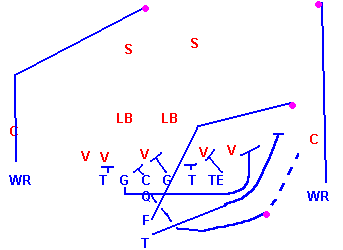 The
roll out option pass is designed as a play where the quarterback can decide
whether to throw the ball to one of three receivers, or run it himself.
It is a play action pass, faking two hand offs, then rolling around end
with a back and a pulling Guard in front of the QB. The offensive
line blocks down to prevent a defender from following the pulling guard,
and the TE double teams the OT's man. The play side DE is left unblocked,
and he and the cornerback are the players the QB read. If either
of these defenders comes to the QB, he passes to one of the receivers.
If the defense retreats into coverage or is blocked, the QB runs behind
his two blockers.
The
roll out option pass is designed as a play where the quarterback can decide
whether to throw the ball to one of three receivers, or run it himself.
It is a play action pass, faking two hand offs, then rolling around end
with a back and a pulling Guard in front of the QB. The offensive
line blocks down to prevent a defender from following the pulling guard,
and the TE double teams the OT's man. The play side DE is left unblocked,
and he and the cornerback are the players the QB read. If either
of these defenders comes to the QB, he passes to one of the receivers.
If the defense retreats into coverage or is blocked, the QB runs behind
his two blockers.
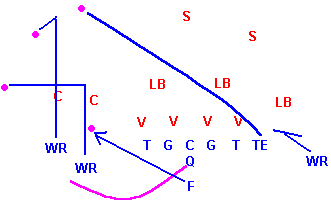 The
Flood Pass is a play that seeks to create a numerical mismatch at the point
of attack. Basically, the flat area is flooded with four receivers and
a quarterback who has the option of running or passing. The quarterback
keys the cornerback to the play side. If the cornerback comes up
to play the quarterback run, the quarterback passes the ball to one of
the receivers. If the cornerback stays back to cover a receiver,
the quarterback has the option to run. The Flood Pass can be run
from a variety of formations, but the more receivers that flood the area
the more likely the play will succeed.
The
Flood Pass is a play that seeks to create a numerical mismatch at the point
of attack. Basically, the flat area is flooded with four receivers and
a quarterback who has the option of running or passing. The quarterback
keys the cornerback to the play side. If the cornerback comes up
to play the quarterback run, the quarterback passes the ball to one of
the receivers. If the cornerback stays back to cover a receiver,
the quarterback has the option to run. The Flood Pass can be run
from a variety of formations, but the more receivers that flood the area
the more likely the play will succeed.
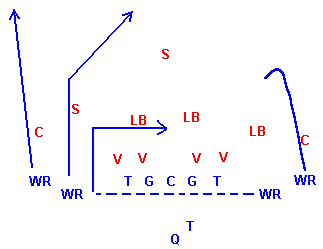 The 971
Pass is similar to the Clear Out Pass but the directive is not to fill
the vacated flat, but rather is intended as a deep threat pass. The
971 Pass has three potential receivers all coming across the quarterback's
line of vision at varying degrees of pattern depth. This pass can
be run from a variety of formations with the third receiver coming to the
area via motion. It is shown here run from the Double Slots Formation
with the off side flanker coming in motion to get to the play side, but
could easily be run with the flanker not in motion but simply running his
crossing pattern from the far side.
The 971
Pass is similar to the Clear Out Pass but the directive is not to fill
the vacated flat, but rather is intended as a deep threat pass. The
971 Pass has three potential receivers all coming across the quarterback's
line of vision at varying degrees of pattern depth. This pass can
be run from a variety of formations with the third receiver coming to the
area via motion. It is shown here run from the Double Slots Formation
with the off side flanker coming in motion to get to the play side, but
could easily be run with the flanker not in motion but simply running his
crossing pattern from the far side.
 The
Screen Pass (shown here: Middle Screen) is a misdirection play intended
to take advantage of an over zealous pass rush and create a mismatch with
the offensive linemen against the linebackers. The offensive line
feints pocket pass protection, positioning themselves to the defenders
inside shoulder and allowing the pass rush to the outside shoulder offering
only token resistance. As the defenders pass the offensive linemen,
the quarterback tosses the ball to the intended receiver and he follows
the linemen to the linebacker positions utilizing his blockers. The
Screen Pass can be run to either side just as effectively and can be run
from almost any formation. Offensive linemen MUST sell their blocking
attempts for the screen to be effective.
The
Screen Pass (shown here: Middle Screen) is a misdirection play intended
to take advantage of an over zealous pass rush and create a mismatch with
the offensive linemen against the linebackers. The offensive line
feints pocket pass protection, positioning themselves to the defenders
inside shoulder and allowing the pass rush to the outside shoulder offering
only token resistance. As the defenders pass the offensive linemen,
the quarterback tosses the ball to the intended receiver and he follows
the linemen to the linebacker positions utilizing his blockers. The
Screen Pass can be run to either side just as effectively and can be run
from almost any formation. Offensive linemen MUST sell their blocking
attempts for the screen to be effective.
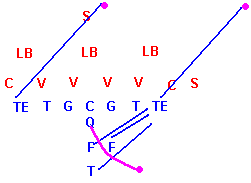 The
Double Fade Pass is designed to be run from a formation featuring two tight
ends. Shown here executed from the Power I Formation, the concept
involves establishing or emulating the run, then going to the pass.
The intention is to lull the defense into playing only one safety, then
sending two receivers into the defensive back field angling with the direction
of the quarterback and forcing the safety to choose which receiver to cover,
then throwing to the other. The line blocks in Fence style protection
to deter the linebackers from keying on drop back protection and dropping
back into coverage themselves. For best results, the Double Fade
should utilize a sound run fake taking on the properties of a play action
pass.
The
Double Fade Pass is designed to be run from a formation featuring two tight
ends. Shown here executed from the Power I Formation, the concept
involves establishing or emulating the run, then going to the pass.
The intention is to lull the defense into playing only one safety, then
sending two receivers into the defensive back field angling with the direction
of the quarterback and forcing the safety to choose which receiver to cover,
then throwing to the other. The line blocks in Fence style protection
to deter the linebackers from keying on drop back protection and dropping
back into coverage themselves. For best results, the Double Fade
should utilize a sound run fake taking on the properties of a play action
pass.
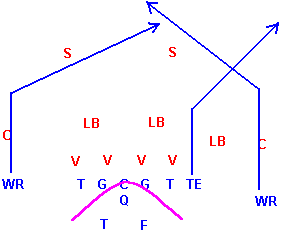 The
Deep Cross is sometimes referred to as a "pick" play because the design
calls for one receiver to pick or screen off another receiver's defender
down field. Contact of course is not allowed. The screening
player must create the pick by the position of his body, keeping himself
between the defender and the intended receiver. The line pocket pass
protects as in most deeper patterns. Different secondary receivers
can be specified, but I recommend these alternate receivers run outside
patterns so as to not congest defenders in the middle of the field.
The
Deep Cross is sometimes referred to as a "pick" play because the design
calls for one receiver to pick or screen off another receiver's defender
down field. Contact of course is not allowed. The screening
player must create the pick by the position of his body, keeping himself
between the defender and the intended receiver. The line pocket pass
protects as in most deeper patterns. Different secondary receivers
can be specified, but I recommend these alternate receivers run outside
patterns so as to not congest defenders in the middle of the field.
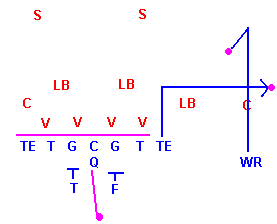 The
52 Hot Pass is a quick developing pass play designed to be used with two
receivers to the same side. It is a simple play with the tight end
(or inside receiver) doing a 10 yard hook to the inside while the wide
out does a 5 yard out pattern. The word hot as well
as the omission of a pass pattern numbered seven or higher tells the offensive
line to block in the Fence style keeping the defender's hands down.
The 26 Hot Pass is basically the same play, but the wide out runs the 5
yard out, and the tight end runs the 10 yard hook out. All hot passes
use a shorter than normal drop back by the quarterback--about three steps
rather than five or seven.
The
52 Hot Pass is a quick developing pass play designed to be used with two
receivers to the same side. It is a simple play with the tight end
(or inside receiver) doing a 10 yard hook to the inside while the wide
out does a 5 yard out pattern. The word hot as well
as the omission of a pass pattern numbered seven or higher tells the offensive
line to block in the Fence style keeping the defender's hands down.
The 26 Hot Pass is basically the same play, but the wide out runs the 5
yard out, and the tight end runs the 10 yard hook out. All hot passes
use a shorter than normal drop back by the quarterback--about three steps
rather than five or seven.
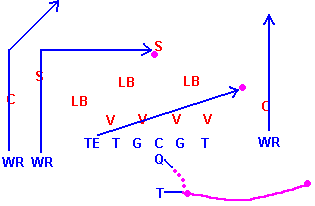 The
Halfback Pass is a deceptive play calling for the running back to pass
the football down field after faking a running play. Shown here from
the basic Pro Set, the running back receives
the pitch out and sprints to the outside as if running the Quick Pitch.
Once to the outside the running back turns passer and throws to one of
the open receivers. This play can be run from virtually any formation
but is run most effective from a one or two back set. The quarterback
can even become a receiver himself back to the far side, but such cross
field passes should be run with extreme care as they are susceptible to
the interception. The deeper patterns should not be the primary targets
for the throwing back as he is probably not as skilled a passer as the
quarterback. Nevertheless, they remain an option.
The
Halfback Pass is a deceptive play calling for the running back to pass
the football down field after faking a running play. Shown here from
the basic Pro Set, the running back receives
the pitch out and sprints to the outside as if running the Quick Pitch.
Once to the outside the running back turns passer and throws to one of
the open receivers. This play can be run from virtually any formation
but is run most effective from a one or two back set. The quarterback
can even become a receiver himself back to the far side, but such cross
field passes should be run with extreme care as they are susceptible to
the interception. The deeper patterns should not be the primary targets
for the throwing back as he is probably not as skilled a passer as the
quarterback. Nevertheless, they remain an option.
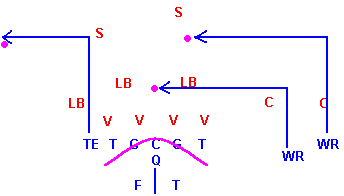 The 314
Pass is a crossing type pass play where three receivers all run in the
same direction offering the quarterback an easier viewing window to pick
a receiver. Shown here run from the Twins (right) Formation, the
314 Pass can be run from most any formation with three wide outs.
However, if run from the Tripps or Quads Formations, the third receiver
should come from the other side. Since all receivers are running
in the same direction as the quarterback, this play can easily be run as
a quarterback roll out pass play.
The 314
Pass is a crossing type pass play where three receivers all run in the
same direction offering the quarterback an easier viewing window to pick
a receiver. Shown here run from the Twins (right) Formation, the
314 Pass can be run from most any formation with three wide outs.
However, if run from the Tripps or Quads Formations, the third receiver
should come from the other side. Since all receivers are running
in the same direction as the quarterback, this play can easily be run as
a quarterback roll out pass play.
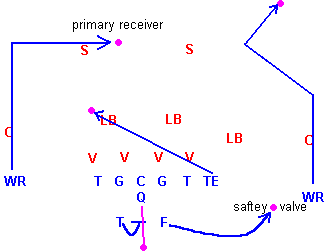 The
Reach Pass is as a medium to long range threat designed to keep a defense
stretched. In reality, the Reach Pass is simply a 20 yard crossing
(or "In") pattern combined with both a deep pattern and a shorter one--usually
a tight end drag across the middle. The tight end Drag should oppose
(come from the opposite direction) the 20 yard cross. A Flag, Post,
Post-Corner, or Fly route can serve as the alternate deep option.
The Line is in pocket pass protection due to the longer pass routes.
The Reach Pass can be run from any formation and with or without the shot
gun. A roll out type pass is not recommended for longer developing
pass routes.
The
Reach Pass is as a medium to long range threat designed to keep a defense
stretched. In reality, the Reach Pass is simply a 20 yard crossing
(or "In") pattern combined with both a deep pattern and a shorter one--usually
a tight end drag across the middle. The tight end Drag should oppose
(come from the opposite direction) the 20 yard cross. A Flag, Post,
Post-Corner, or Fly route can serve as the alternate deep option.
The Line is in pocket pass protection due to the longer pass routes.
The Reach Pass can be run from any formation and with or without the shot
gun. A roll out type pass is not recommended for longer developing
pass routes.
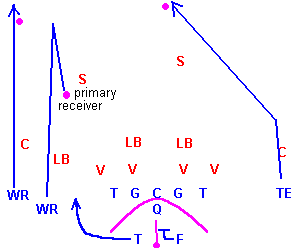 The Come
Backer Pass (CB) is a misdirection type pass. It can be run from
most all formations. At least three deep routes are run, but the primary
receiver sprints for thirty yards then stops and turns very much like a
hook or stop pattern. But the CB takes it one step further.
Here, the receiver runs back to the quarterback at full speed. The
play is designed as a twenty yard reception. The theory is that by
sending three players deep, then having one return so abruptly at full
sprint will cause separation between the primary receiver and his defender.
By so specifically outlining the primary receiver's retreat to the ball,
the Come Backer Pass can be run as a timing pattern, allowing the quarterback
to release the ball before the break by the receiver. The play is
shown run from the Twins Left--Wide (split) Right Formation.
The Come
Backer Pass (CB) is a misdirection type pass. It can be run from
most all formations. At least three deep routes are run, but the primary
receiver sprints for thirty yards then stops and turns very much like a
hook or stop pattern. But the CB takes it one step further.
Here, the receiver runs back to the quarterback at full speed. The
play is designed as a twenty yard reception. The theory is that by
sending three players deep, then having one return so abruptly at full
sprint will cause separation between the primary receiver and his defender.
By so specifically outlining the primary receiver's retreat to the ball,
the Come Backer Pass can be run as a timing pattern, allowing the quarterback
to release the ball before the break by the receiver. The play is
shown run from the Twins Left--Wide (split) Right Formation.
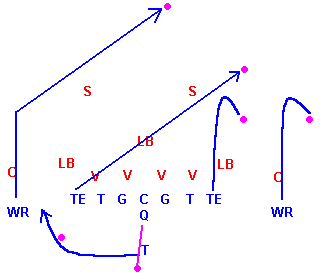 The Flex
Pass is another deep threat pass play. The play features two receivers
to the same side both performing 10 yard hook outs. Two receivers
from the other side then run deeper routes to the same side as the hooks.
The inside receiver to the opposite side runs a direct pattern (slant)
to get to the area quicker. The outside receiver runs an angled pattern
(post) to arrive a count later. In the diagram shown here, the back
blocks first to check the blitz, then releases in a Curl (Zero) pattern.
Since at least one deep pattern is run, the offensive line pocket pass
protects. Since four receivers are to the same side, the quarterback
roll out is an option. The deeper receivers are the primary receivers.
The Flex
Pass is another deep threat pass play. The play features two receivers
to the same side both performing 10 yard hook outs. Two receivers
from the other side then run deeper routes to the same side as the hooks.
The inside receiver to the opposite side runs a direct pattern (slant)
to get to the area quicker. The outside receiver runs an angled pattern
(post) to arrive a count later. In the diagram shown here, the back
blocks first to check the blitz, then releases in a Curl (Zero) pattern.
Since at least one deep pattern is run, the offensive line pocket pass
protects. Since four receivers are to the same side, the quarterback
roll out is an option. The deeper receivers are the primary receivers.
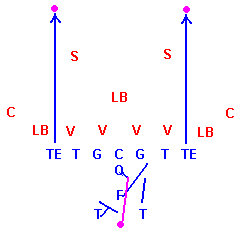 The
Renegade Pass involves two tight ends both running the fly pattern up the
middle of the field. This play can be run from any formation
providing at least one tight end is used. The role of the second
tight end can be played by a wide out coming in motion to the inside.
The Renegade Pass is designed to present and maintain a deep threat by
the tight end position by stretching the defense in the middle of the field.
The receivers run directly up field looking over the outside (sideline)
shoulder to the quarterback at all times. The run fake should be well executed
so as to keep the linebackers honest and freeing up the tight ends to sandwich
the safety.
The
Renegade Pass involves two tight ends both running the fly pattern up the
middle of the field. This play can be run from any formation
providing at least one tight end is used. The role of the second
tight end can be played by a wide out coming in motion to the inside.
The Renegade Pass is designed to present and maintain a deep threat by
the tight end position by stretching the defense in the middle of the field.
The receivers run directly up field looking over the outside (sideline)
shoulder to the quarterback at all times. The run fake should be well executed
so as to keep the linebackers honest and freeing up the tight ends to sandwich
the safety.
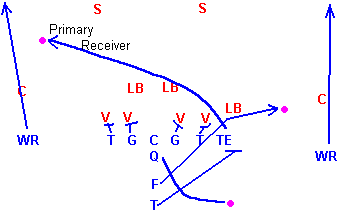 The
Back
Door Pass is a misdirection, play action, roll out pass intended to
start the defense one way then reversing direction and passing the ball
back to the other side. The Quarterback's primary receiver is the Tight
End which has run a slower than normal developing drag pattern 10 to 15
yards deep. A pass thrown across the field is often susceptible to
a damaging interception. To minimize the risk of an interception
the Quarterback throws the pass over the outside shoulder of the Tight
End. The Back Door Pass is vulnerable to the weak side blitz and
special care should be taken by the Quarterback to avoid the sack when
he reverses his footing to throw back across the field. If the Quarterback
feels too much pressure from the back side, he may opt to continue the
roll out and throw to his secondary receiver, the Full Back or back out
of the back field that took the run fake and flared out to the strong side
flat.
The
Back
Door Pass is a misdirection, play action, roll out pass intended to
start the defense one way then reversing direction and passing the ball
back to the other side. The Quarterback's primary receiver is the Tight
End which has run a slower than normal developing drag pattern 10 to 15
yards deep. A pass thrown across the field is often susceptible to
a damaging interception. To minimize the risk of an interception
the Quarterback throws the pass over the outside shoulder of the Tight
End. The Back Door Pass is vulnerable to the weak side blitz and
special care should be taken by the Quarterback to avoid the sack when
he reverses his footing to throw back across the field. If the Quarterback
feels too much pressure from the back side, he may opt to continue the
roll out and throw to his secondary receiver, the Full Back or back out
of the back field that took the run fake and flared out to the strong side
flat.
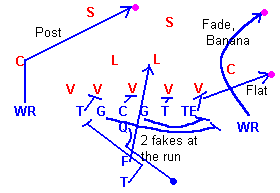 The
Cross
Buck Pass is a Play Action Pass utilizing two ball fakes to sell the
run. A deviation of Ron Schipper's Cross Boot (Hawkes,
p.63). The quarterback then sets up to throw the ball to one of three
receivers, four if the fullback fills the middle zone. The quarterback
should drop back deep enough to square his shoulders to the line of scrimmage
particularly if he will be throwing against the flow of his own body, as
in to his weak side. The Tight End blocks for two full counts before
filling the flat. This play can be run from any formation featuring
two backs but works best with at least three receivers.
The
Cross
Buck Pass is a Play Action Pass utilizing two ball fakes to sell the
run. A deviation of Ron Schipper's Cross Boot (Hawkes,
p.63). The quarterback then sets up to throw the ball to one of three
receivers, four if the fullback fills the middle zone. The quarterback
should drop back deep enough to square his shoulders to the line of scrimmage
particularly if he will be throwing against the flow of his own body, as
in to his weak side. The Tight End blocks for two full counts before
filling the flat. This play can be run from any formation featuring
two backs but works best with at least three receivers.
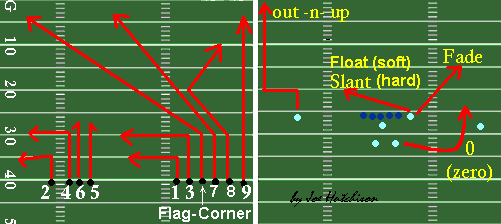 the outside. Basic patterns are to the left in the diagram, specialty
routes to the right. Pass routes can be called by number or by name.
In a passing play like the 838 Deep Cross, the numbers specify that the
outside receiver run a #8 patter, the man next inside him a #3 pattern,
the next receiver another #8 pattern. Of course, patterns can be
modified. For example the Float is merely a soft, dragging slant
pattern. The out and up is a combination of a five yard out pattern
and the Fly pattern. The pass routes or patterns depicted here are numbered
as follows. #0=The Zero or Curl Pass. #1=5 yard
Cross or In. #2=5 yard Out or Sideline. #3=10
yard Cross. #4=10 yard Out. #5=10 yard Hook or
Stop (In). #6=10 yard Hook (Outside). #7=Post.
#8=Post
Corner. #9=Fly or Go. I personally do not favor pass
route numbers higher than one digit as this hampers many play calling techniques.
Other pass routes can be specified by letters of the alphabet or by name,
as in the Flag, Fade, Slant, Float, and the Out and Up.
Many coaches use what I call the Banana route where a pattern such
as the Post is rounded or bowed in shape.
the outside. Basic patterns are to the left in the diagram, specialty
routes to the right. Pass routes can be called by number or by name.
In a passing play like the 838 Deep Cross, the numbers specify that the
outside receiver run a #8 patter, the man next inside him a #3 pattern,
the next receiver another #8 pattern. Of course, patterns can be
modified. For example the Float is merely a soft, dragging slant
pattern. The out and up is a combination of a five yard out pattern
and the Fly pattern. The pass routes or patterns depicted here are numbered
as follows. #0=The Zero or Curl Pass. #1=5 yard
Cross or In. #2=5 yard Out or Sideline. #3=10
yard Cross. #4=10 yard Out. #5=10 yard Hook or
Stop (In). #6=10 yard Hook (Outside). #7=Post.
#8=Post
Corner. #9=Fly or Go. I personally do not favor pass
route numbers higher than one digit as this hampers many play calling techniques.
Other pass routes can be specified by letters of the alphabet or by name,
as in the Flag, Fade, Slant, Float, and the Out and Up.
Many coaches use what I call the Banana route where a pattern such
as the Post is rounded or bowed in shape.